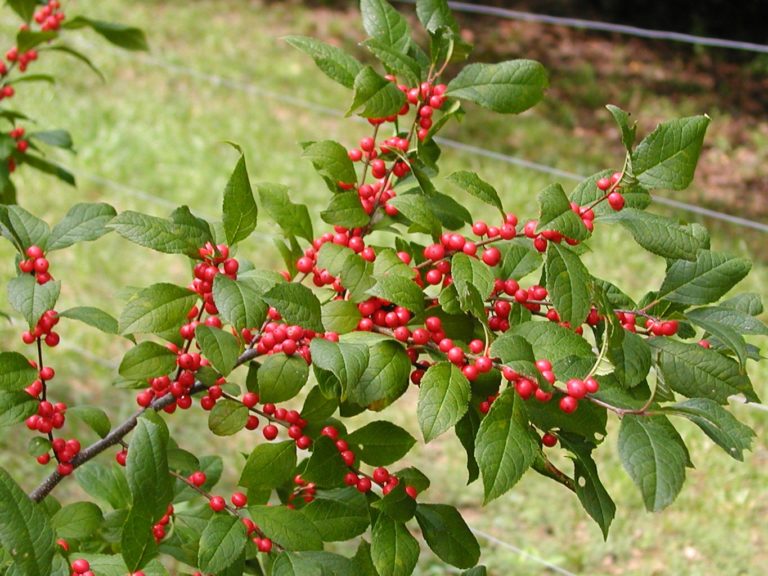Winterberry is a handsome deciduous shrub, averaging twelve to fifteen feet tall, with gray, twiggy, horizontal branches and spectacular red berries in winter.. It is native to swampy, wet areas of Eastern North America. Winterberry prefers full sun and moist, well drained, acidic, organic upland soil. However, it can also tolerate “wet feet”. The glossy, oval, serrated, dark green leaves of Winterberry turn a nice yellow during the fall before dropping off for winter. Like all hollies, Winterberry is dioecious (separate male and female plants). Small, whitish, inconspicuous flowers bloom in mid-summer, attracting bees and other pollinators. If a male of the same species is nearby, flowers on female plants will give rise to the thick clusters of red berries among the green leaves, or packed around the grey stems after leaf drop. The fruit of the Winterberry is very tart and only becomes the food of choice to animals in the late winter, assuring us a long season of “winter interest”. This dramatic and long-lasting splash of bold color accounts for the popularity of this plant among gardeners. In addition to being beautiful, these shrubs also support birds in large numbers late in the season, even into early spring. A number of cultivars exist for this species in the horticultural trade, although the cultivars are not as favored by either insects or wildlife (MinnesotaWildflowers.Info). It is a great plant for use in rain gardens.
NURSERY HOURS
Wednesday: 10-4 Thursday: 10-6 Friday-Saturday: 10-4 Sunday: 12-4
Ilex verticillata

Key Info
Common Names: Winterberry, Winterberry Holly, Common Winterberry, Michigan Holly, Black Alder, Brook Alder, Canada Holly, Coralberry, Deciduous Winterberry, False Alder, Fever Bush, Swamp Holly, Virginian Winterberry
Family Names: Aquifoliaceae (Holly Family)
Plant Type: Tree / Shrub
Leaf Retention: Deciduous
Flower Color: White
Special Characteristics: Showy fruit (females), Good for hedges, Good wildlife cover/habitat, Attracts bees, Attracts butterflies, Attracts birds, Tolerates wet conditions
Additional Info
Habit: Multi-stemmmed, upright, rounded habit with medium texture, the larger stems up to 2 inches diameter; bark thin, smooth and grayish brown; may create colonies from root suckers, especially in wet conditions.
Height: 6' to 10'
Spread: up to 10'
Soil Conditions: Moist to wet, acidic soils; sandy, sandy loam, medium loam, clay loam, clay.
Leaves: Alternate, simple, elliptic to obovate, with a serrated to doubly-serrated margin, the teeth shallow and often with a minute projection at the tip; glabrous (flat or glossy) dark green above, paler and generally pubescent below, with an acute base and tip. Leaves are variable in size, sometimes even on a single branch, ranging from 1-4 inches long and half as wide. Fall color is not outstanding, typically yellow-green with some purple tinges.
Flowers (or reproductive structures: Axillary flowers are fragrant, small (1/4 inch diameter), inconspicuous, with five to seven white petals, in late spring; male flowers are clustered 3-25 in short, pedunculate cymes in the leaf axils; pistillate flowers are solitary or in 3-flowered, sessile cymes in the axils of the leaves.
Fruit: The 1/8 - 1/4-inch, smooth berries are technically drupes, spherical, red, opaque, containing 1 to several nutlets; held close to the stem; ripening in fall but persisting through the winter.
Natural Distribution: Bogs, along streams and ponds, low woods, damp thickets
USDA Hardiness Zone: 3 to 9
USDA Wetland Indicator Status in NC: FACW
Pollination: Bees, butterflies, other insects
Wildlife Connections: The flowers attract large numbers of honey bees, native bees and other pollinators; the foliage supports caterpillars of various kinds and is larval host for Henry's Elfin butterfly; many birds eat the fruit; good cover and nesting sites for birds.
Propagation: From seed (takes a long time to germinate, needs stratification) or from root sprouts.
